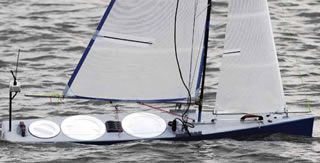
Photos by Ralph Naranjo
A lot can be learned from really small boats that carry no crew. In fact, sailing robotics-SailBot for short-is attracting sailors and engineering students from universities across North America and Europe. These competitive research programs are a proving ground for on-the-water autonomous craft, and they give us a glimpse of what the future of marine electronics may have in store.
Todays electronics manufacturers tout networked systems that take GPS position information and display it on multi-function displays (MFDs), and they even allow you to match up your point-to-point developed routes with an onboard autopilot. But SailBot engineers have gone one step further. Their boats sail with artificial intelligence (AI) and servo systems that allow them to tack, jibe, and make navigational decisions based on algorithms coded into software by this modern breed of sailors.
PS Technical Editor Ralph Naranjo, a design judge at annual SailBot competitions, has observed these scaled-down innovations in action. For example, these boats demonstrate the accuracy of WAAS-enhanced GPS through their precise position-holding accuracy, and Naranjo noted that the GPS antennas worked better away from the masthead, in a spot where acceleration changes due to pitch, roll, and yaw have a less exaggerated influence.
In todays world-where flying drones are playing a key role in military combat and private-sector businesses are looking into low-level flights piloted by AI to deliver pizza-its no surprise that the concept has caught the interest of sailor/engineers, remote-control (RC) model boat aficionados, and midshipmen in the U.S. Naval Academy (USNA) Naval Architecture Program. Their custom designs result in small sailboats packed with big-league computing capacity, and a few of the features go well beyond whats found in the uber-networked electronics of most 50-foot cruisers and racers.
Dr. Paul Miller, a materials specialist and associate professor in the Naval Architecture Program, has been a pioneer in the SailBot revolution. His students have focused on hull shape development, sails and rig advancement, and have tackled the challenges of sensor selection, servo installation, and onboard computing.
AI has been viewed as analogous to an organic brain, with cyber-decision making mimicking how the frontal lobe of the human brain handles real-time tactical decisions regarding steering, sheeting, and picking a course. At the same time, the circuitry replicating the midbrain ponders sensor inputs (location, speed, course, conditions) and responds to feedback from the cerebellum-like hind brain, which collects motion and position data, filtering it for long-term storage to learn from past successes and mistakes.
The annual North American championship has been held in 3- and 6-foot-long robotic sailboats, with the latter dominating. The regatta comprises five scored segments that include a fleet race around a fixed course featuring windward-leeward and wings marks. Another segment is a station-keeping endeavor, in which the boat must enter a 40-meter (131 feet) by 40-meter box and remain in the box for five minutes. If the AI fails and remote radio control is used, a 50-percent reduction in score is levied. This event puts the logic and servo linkage aspects to a serious test.
Other components of these annual competitions include an endurance contest, a 10-kilometer (6.2-mile), hands off distance race that also has penalties for taking manual control; another autonomous navigation challenge comprising a windward-leeward leg with start/finish gates; and finally, a panel of experts evaluates each groups design presentation, focusing on each boats quality, attention to detail, and level of innovation.

One of the biggest challenges in designing a SailBot is meeting the twin goals of speed and controllability. This has led entrants to devise heavy- and light-air rigs and boats with proportionally deeper draft and a higher ballast-displacement ratio than seen elsewhere in sailing. These 6-foot-long lead mines go upwind at grand prix boat tacking angles, with decks awash and a need to be sealed up as tightly as a submarine.
Sensors are another key factor, and WAAS-corrected GPS has proven sufficient for precise position updating. But when using a combined wind point and wind-speed GPS sensor at the masthead, pitch and roll have had some undesirable effects.
Another challenge is servo operation and how to lessen the forces linked to trimming and rudder control. By opting for a semi-balanced, high-aspect-ratio spade rudder, part of this problem is solved, but that still leaves the need to handle sheet trimming loads. Using smarter codes that dampen overly responsive trim controllers has made some inroads in this realm.
International SailBot Competition, includes a 4-meter class and an open challenge involving a trans-Atlantic passage. Drift buoys have made such crossings, and not long ago, a Regulator runabout that flipped off the coast of New England showed up in Spain. The point is that the challenges facing innovative young designers looking for the right sailboat design to cross the Atlantic is far from whats needed to win inshore smooth-water buoy races.
Theres a need for a sailplan that can cope with winds ranging from calms to gales. Perhaps a fixed foil for a rig and sailplan is a better alternative. In 25 knots of wind or more, the boat would heel over like a Mola Mola (Ocean Sun Fish) taking a nap and scoot along with the current. Whatever the design, electrical energy will be a limiting variable and the design challenges include the complexity of reefing and the challenge of steering in oceanic conditions.
A miniaturized, 24/7-operating autopilot would have to sip electrical current or be swapped for a scaled-down self-steering vane. In addition, the scan’tlings and stability of the SailBot boat must be able to handle wave impacts, capsizes, and tangles with flotsam. All of these challenges and the ability to go from design development and construction to on the water competition make robotic sailboats the sailor/engineers perfect puzzle to ponder.
Conclusion
If all this sounds too far-fetched to be entering the mainstream soon, think again. B&G has rolled out instruments that put start-line decision making in a black box. Not only does the display graphically show the favored side of the start line, but it gives the number of boat lengths one side is favored over the other. Information such as time to the line, a graphic display of the currents set and drift, and a full array of wind data is all in plain sight. How long will it be before auto tacks and pressure-sensor sail trimming enter the fray?
The University of Rhode Island (URI) recently launched a 36-foot catamaran sans rig that will head to sea for a month at a time measuring major currents and doing other physical oceanography work. Dan Codiga, a URI research scientist who runs the project, sees autonomous operation as a cost-effective approach to vital data gathering.
The big question that arises, however, is with the advent of more electronically guided cars and boats, will sailing be enhanced or will it become a spectator sport? Perhaps well end up with yet another remote control for the TV, and simply click it on when we want to see where our cruising drone has wandered.





































